September 2 - 8, 2012: Issue 74
Avalon Sailing Club
By Norm Field
Commodore 1998-1999
The majority of this story of Avalon Sailing Club I have interpreted from the minute books Ian Craig (our secretary) and I discovered in the club office during our regular working bees. I felt it would be a disaster to leave this history to be eaten by silverfish (they have now moved to my house) so I started the project. In the process I was privileged to meet a lot of people who made the club possible, and they helped me keep the record straight as well as providing photographs and names of people in the photographs. Many thanks to Les Vaughan, Bill Toft, Bill Davidson, John Lingard, Ken Hudson, Phil Rudder, David Forbes, Tony Bellingham, Don McLachlan, Mary Ifould, June Ryves and that walking encyclopaedia from Royal Prince Alfred, Jack Gale.
A.S.C. has always provided a great ab initio training for young sailors to introduce them to the joys of the sport before they move on to more competitive arenas. Just a few names from more recent times are Grant Simmer, Phil Bate, Tony Bellingham, Glen Attrill, and James and Katie Spithill. Our current patron is Iain Murray and he and his wife Alex have contributed greatly to our junior training programme.
The early patrons from the Clareville Beach start days H.G. Bellingham, H. Gregory Foster and Phil Goldstein (yacht Archina, 3rd in 1947 Hobart Race) provided permanent trophies which are still with the club. They were friends with a lot of the local residents including Stan Fox who owned the house just around the corner south of Taylors Point. You can still see his house from the Taylors Point Mark. His cruiser the Miss Eve used to follow the races and he donated the Miss Eve trophy to the club. The club is still a family affair and the annual replacement of the boards on the deck still occurs and yes, the nails still pop up. The V.J.s have gone to be replaced by M.J.s, Flying 11s, Spirals, Nippas, Lasers, 29’ers, and there is now a large yacht racing and cruising division, sailing every Sunday through summer and once a month in winter.
The Formative Years
A promotional gazette by Sydney city auctioneers Robjohn and Associates in the 1920’s proposed introducing “the city businessman” to the beauties of Pittwater. Proposed development of the area assured prospective buyers of regular ferry services between Newport and wharves in Pittwater and the Hawkesbury as well as a tram service to Taylors Point and Palm Beach, “in the process of construction”. Barrenjoey Road had only just been upgraded from a cart track and surfaced with macadamite at this stage. A 1922 photograph shows the area from Stokes Point to Taylors Point devoid of wharves, ramps and swimming pools with the exception of the wharf at Clareville, the remains of which are in the cage beside the present Avalon Sailing Club. It was from this wharf that timber was sent to many ports in Australia during the early days of the Pittwater colony.
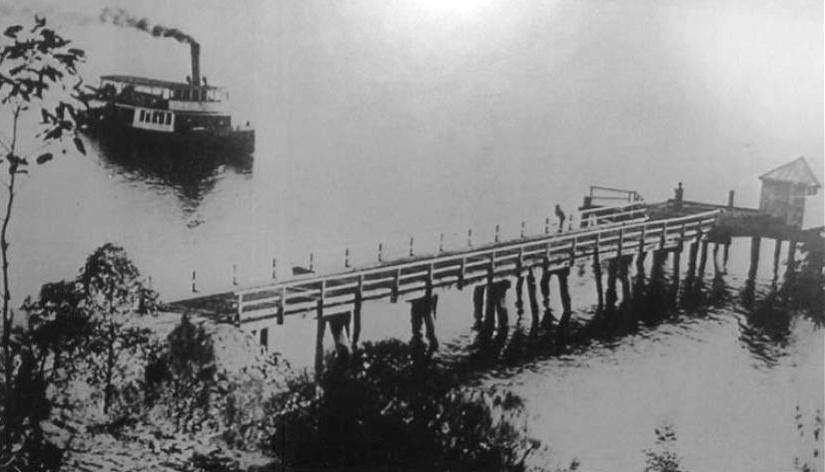
Ferry Steamer Approaching Clareville wharf, 1920
The price of a block of land on the waterfront averaged out at 150 pounds for a 50 foot wide block in the area extending from the beach at Taylors Point to Hudson Parade.
Mr. J.G. Vaughan, an engineer with the Wakefield Oil Co., had the weekend use of a house just to the south west of the Clareville Park and in 1932 introduced his family to the unspoilt beauty of the area. His teenage sons, Les, Harold and Ken were keen sailors with the Middle Harbour Skiff Club and equally keen to sail on Pittwater. However he was concerned that the boys could not be supervised on the waters off Clareville Beach especially as the dinghies of those days were non righting and had to be towed or paddled home.
His concerns were alleviated with the Vaucluse Junior, or V.J., which had first appeared upon the scene in 1931. Designed by a young naval draughtsman, Charles Sparrow, with a lot of enthusiasm and support from Sil Rohu, a Sydney businessman and keen sailor, the V.J. could be built at home from the comprehensive set of plans that cost 10 shillings. The most important aspect of the boat was that apart from a small canvas well she was completely decked in, unsinkable and could be righted by the crew without external help.
The Vaughan family built their first boat, Defiance, in the boat shed and bought the next one, Flash, second hand, in 1933. The two older boys, Les and Harold, set up their own race course in the area to the north of Taylors Point and to supplement their pocket money would stage mock pirate landings and sword fights at Clareville on a Sunday, to the delight of the local residents. The “donations” were then collected and placed in the treasure chests which were the canvas wells of the V.J.s. The Vaughan's nearest neighbours were the O’Connor family, who owned the Sir Walter Raleigh Hotel at Kings Cross and also owned a motor cruiser, the M.V. Raleigh. The two O’Connor daughters joined in the pirate jousting not only as damsels in distress but assistant collectors of the booty.
The local families combined to share a jig frame for the V.J. construction and by 1935 there were six boats sailing off Clareville Beach all made with cedar planking and with either home made or professionally cut cotton sails. By 1937 Mr. Vaughan decided that his boys were either making too much money as entrepreneurs or on the road to ruin so he made a set of marks and laid out a course, starting off Clareville and using the area between Taylors Point, Paradise Beach and Long Nose Point. A system of coloured flags was used representing minutes to start in a handicap start system so in theory all boats should finish together. Entry fee was two shillings and the prize money was divided proportionally among the first three boats. (Maybe some of Australia’s best known sailors lost their amateur status in those early years.)
Les approached his father to help with the purchase of a car and received the profound advice that a car was a poor investment, son, and he should look to the future and buy a house. An adjacent house with views north to Lion Island and a reserve to the beach was for sale and Les approached the owner, a teacher at Chatswood school, and offered a deposit of one Pound which was accepted. This house and the next door boat shed were where the family laid the foundations of Avalon Sailing Club.
In 1938 J.G. Vaughan officially formed Avalon Sailing Club and donated a handsome silver cup for the annual V.J. Championship. The first winner in 1939/40 was Harold Vaughan sailing Defiant and again in 1940/41.
The list of boats and owners for that season is as follows:
Defiant H. Vaughan, Flash L. Vaughan, Gloria Miss L. O’Connor, Wings Miss B. O’Connor (Champion 1942/43), Spray Miss J.P. Hippard, Avalon G. Harrington, Panther H. Webber, Le Hero J. Rodd, Water Witch, Skippey, Q.E.D.
The O’Connors had run into a few problems with the licensing police at Kings Cross in 1942 and to help out financially J.G. Vaughan purchased the Raleigh, which became the official start boat, and the O’Connor house and boat shed.
The reality of the War came to Pittwater at the end of 1942 with the construction of the R.A.N Torpedo Range on the public reserve and baths at Taylors Point. This consisted of a long access jetty with firing station and three targets at 1000 yard intervals held in position by six large buoys. The aiming point was a large blob of white paint that had been poured over a cliff face on Lion Island. (No consultation with the penguins or the National Parks and Wildlife.) The Range brought another A.S.C. family into the area with the arrival of Frank Lingard as foreman to the project, moving into a commandeered house at 107 Hudson Parade in 1943. The torpedo testing commenced in January 1944 and in addition a boom gate was built between West Head and Barrenjoey.
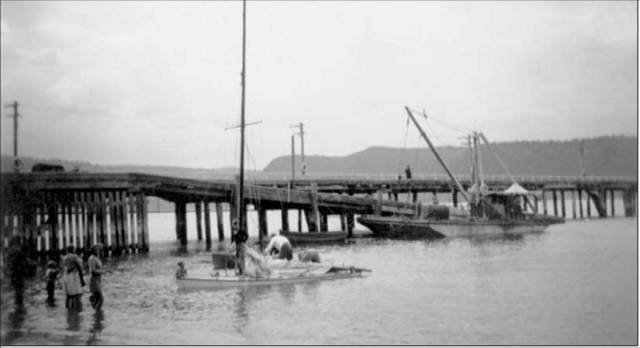 A Defence order requiring all boats to be removed from Pittwater within
24 hours is recorded on the Championship Trophy as “1943/44 Activities suspended
due war service”. The V.J.s were stored in various boat sheds and back yards and
Les Vaughan, in the Naval Reserve at this stage managed to move the
Raleigh to Middle Harbour where she remained until the end of the
war.
A Defence order requiring all boats to be removed from Pittwater within
24 hours is recorded on the Championship Trophy as “1943/44 Activities suspended
due war service”. The V.J.s were stored in various boat sheds and back yards and
Les Vaughan, in the Naval Reserve at this stage managed to move the
Raleigh to Middle Harbour where she remained until the end of the
war.
The High Command must have relented towards the end of 1944 as the Club re-opened on the 14th October that year and at the meeting held in the Vaughan’s boat shed the new office bearers unanimously decided the club should be named the Avalon Sailing Club. J.G. Vaughan was elected President (just as well, as it was his original idea, his boat shed and he also provided the car battery for the lighting in the shed) and Les Vaughan was made Club Captain. Above: Harold Vaughan and his sinking Jubilee class off the Torpedo Wharf
Annual fees were set at 2/6 for boat owners and 2/- for social members and crews. A handicap start from between the centre of Clareville Beach and a launch to the south was to be used and a roster drawn up for laying of a mark at Long Nose Point by a V.J. and a similar retrieval roster. (Fuel was still rationed.) The first race was held on the 15th October and there were 16 V.J.s competing.
Although the war in Europe was slowly grinding to an Allied victory towards the end of 1944, the Pacific war was still in full gear. The gloom of the early years had lightened and, despite the shortages and rationing, people made the most of what was available. All the houses around Clareville Beach were family-built holiday homes so the weekend residents would save their petrol ration (or those with gas bags attached to the car roof the cars burnt coke for the gas) and drive north to Pittwater from the Sydney suburbs.
Another big family group joined the Club in late 1944. The Gravenors, two brothers and their families (four sons) moved into their father’s house at 28 Delecta Avenue, Clareville. The four boys within six months had V.J.s sailing at the Club called Astra, Altair, Aloha and Aurora. The Vaughans and the Gravenors were to be the mainstays of the Club over the coming ten years. Ken and Alan Gravenor were given the responsibility of designing and manufacturing the first club pennant which they managed in two weeks and handed to the committee in January 1945 for which they received the princely sum of 25 shillings.
The Club’s first dance was held on Anniversary night in January at Amorey’s cafe/hall at Avalon with the cost of the hall being donated by Mr. Amorey, who was similarly benevolent to the Avalon Lifesaving Club. Two other firsts appeared the same month. This was the introduction of a monthly helter skelter race where the V.J.s were rigged and ready on the beach and the skipper and crew had to race to their boats from a starting line. (What would now be called a Le Mans start?) The other first was the introduction of a ladies day race where, under the rules, the owner could take over the boat in an extreme emergency but must then retire from the race.
Avalon delivered a challenge to Vaucluse Sailing Club in March 1945 with four boats representing the Club on the Harbour and Vaucluse reciprocated on Pittwater two weeks later, results unknown unfortunately. The members of the club must have been a well liked group at this stage (this changed with the first attempt at a clubhouse) as the local residents donated trophys and cash for prizes. There were 16 V.J.s sailing, all locally registered with different sail colour patches such as blue lion, southern cross, flying horse etc, and as most races were handicap start the finishes were hotly contested. The first official prize giving and dance was held in May 1945 at the Chatswood Town Hall (the Vaughans lived at Chatswood) with nearly 100 people attending.
September 1945 saw another local family join the Club. Rick, Boyd and Beris Corben together with Ken Humphries who joined at the same time were all to become active members and champion sailors. The Forbes family also had a holiday home at Palm Beach and Rick built a V.J. for Esther Forbes, who shortly after joined the club. He also taught her brother, David, how to sail on this boat. David then built his own V.J. and said that it was probably good for him sailing the modified V.J. single handed from Palm Beach to Clareville and back at the end of the day’s racing. It must have done something for his later renowned, international expertise. There was a notice board on the beach listing the sailing days and Ken supplemented this with a sketch of the courses and colour cards showing the various boats, sail emblems and names as there was such spectator interest. Who said watching sailing was like watching grass grow!
The three torpedo targets which had been installed in 1943 and were so convenient as marks of the course had now become a menace as the six large buoys fixing each target were waterlogged and a hazard to all surface craft. A Lieutenant Pettigrew of the R.A.N. was approached to improve the marking of the buoys and a month later prior to the 1946 Pittwater Regatta another letter was sent to the Naval Board with a similar request to clear the fouled buoys. (The targets were finally moved in 1970.)
January 1946 nearly saw the demise of Avalon Sailing Club. The Club publicity committee moved that the name be changed to the Broken Bay Sailing Club. Luckily this was postponed until the next season and thankfully went away. One good aspect of the committee was that the race results were now appearing in Tuesday’s Manly Daily.
Two new trophies were donated in 1946 which are both still held by the Club. Mr. H.G. Bellingham donated the Bellingham Shield for the handicap champion and Gregory Foster the Clareville Cup for inter-club competition. The latter caused some ill feeling as the Vaucluse Club was in charge of the Vee Jay affiliated clubs and Avalon was in the rogue group which allowed slightly larger spars and sailing one up due to the lack of forward hands. Consequently Vaucluse, Connell’s Point and the River Club refused the invitation unless all clubs became affiliated with the V.J. Association. The first Clareville Cup race was therefore sailed regardless of other clubs and affiliation, and of course won by Avalon.
Either the Club membership was growing or Mr. Vaughan’s 12 volt battery that provided the lighting for the boat shed meetings had died, so the September 1946 A.G.M. was transferred to Wickham’s Store at the corner of Old Barrenjoey Rd. and Avalon Parade. Around this stage plans had been drawn up for the construction of a clubhouse and they were submitted to Warringah Council. (Twelve years later the clubhouse was opened after years of frustration, but more of that later.)
Discussions were also held with the Elwood Sailing Club in Victoria regarding an additional Class to the V.J. The two Class boats investigated were the Seahorse and the International Star with Harold Vaughan (returned from Army service) to obtain the information. The extra Class eventually was the Vaucluse Senior (V.S.) but five A.S.C. Members were to become Australian Star class champions and one Olympic gold.
By 1947 there was a great influx of family members into the Club. One of the Gravenor brothers, Reg, a local builder who owned the house beside Clareville Beach park and was involved in constructing a number of the waterfront homes along the beach as well as Careel Bay, introduced many of the new residents to A.S.C. Some notables among the the new members in 1946/47 were the Toft brothers, and the Forbes brothers.
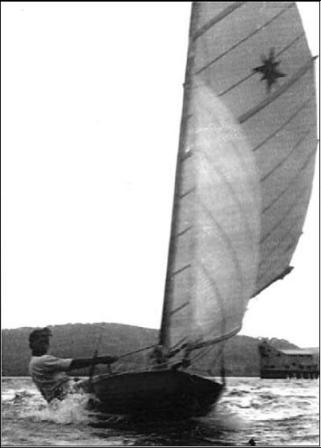 Avalon
has always provided a training ground for some of Australia’s greatest sailors
and these early days were no exception. The club was frustrated for ten years in
its attempt to build a clubhouse and as the members grew in size and age they
were on the lookout for an international class boat to further their ambitions.
The favoured boat in those days was the International Star, a tweaky brute of a
boat with a huge mainsail, designed back in 1911 especially for one design
racing, but unfortunately it had to be kept on the hardstand. Eventually in the
sixties some of our members moved on to the R.P.A.Y.C. to sail Stars with a very
impressive record.
Avalon
has always provided a training ground for some of Australia’s greatest sailors
and these early days were no exception. The club was frustrated for ten years in
its attempt to build a clubhouse and as the members grew in size and age they
were on the lookout for an international class boat to further their ambitions.
The favoured boat in those days was the International Star, a tweaky brute of a
boat with a huge mainsail, designed back in 1911 especially for one design
racing, but unfortunately it had to be kept on the hardstand. Eventually in the
sixties some of our members moved on to the R.P.A.Y.C. to sail Stars with a very
impressive record.
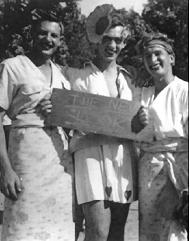 1947: There
were now 29 V.J.s registered with the club and most of the races were still
handicap starts. Avalon was still the renegade V.J. Club allowing one up racing
and bigger rigs. Note the 1947 photo of Bill Toft sailing Comet
(right), with the Taylors Point torpedo station in the background and NO
lifejacket. Every Easter from 1947 the club held a carnival at Clareville Beach
with raffles, chocolate wheel prizes, cake stalls, mock pirate attacks and the
Avalon belles, displaying the latest fashions to the assembled crowd. The
purpose was to obtain money for the intended land lease from Warringah Council
to erect a clubhouse.
1947: There
were now 29 V.J.s registered with the club and most of the races were still
handicap starts. Avalon was still the renegade V.J. Club allowing one up racing
and bigger rigs. Note the 1947 photo of Bill Toft sailing Comet
(right), with the Taylors Point torpedo station in the background and NO
lifejacket. Every Easter from 1947 the club held a carnival at Clareville Beach
with raffles, chocolate wheel prizes, cake stalls, mock pirate attacks and the
Avalon belles, displaying the latest fashions to the assembled crowd. The
purpose was to obtain money for the intended land lease from Warringah Council
to erect a clubhouse.
Left: The Avalon belles at Clareville in 1948 - Bob Hanson, Peter Docket and Bill Toft
The Battle for the Clubhouse
As well as the carnivals at Clareville, theatre parties were organised by the then secretary Don Hudson (Ken’s cousin) to raise money for the land lease. Warringah Council was again formally approached in November 1948 and a new set of plans presented as the Council appeared to have lost the previous application. There were various vacant waterfront blocks between Clareville Beach and Taylors Point and Reg Gravenor was authorised to approach the owners, some of whom had children sailing, with an offer. In today’s terms these offers may seem ridiculous. For example 700 pounds for a block just south of the park, to 1250 pounds for Herbie Lee’s mother’s land, to an offer (undisclosed) for the Seaton and Duffs residence at Taylors Point for a ready made clubhouse.
There must have been some opposition from the previously friendly neighbours as the club president, Reg Gravenor, was requested to make a personal approach to the residents to ascertain their objections and find a common basis of agreement so the clubhouse could be built. Evidently it was fine coming to the park to watch the races on a Saturday and Sunday, but a sailing club near your own backyard would be full of one eyed desperados, wearing three cornered hats and parrots on their shoulders, clutching bottles of rum and singing “Yo ho ho” to all hours. It was decided to again approach Councillor Berry at the council to ascertain the Shires policy on obtaining club land, as well as the Lands Department. Getting closer, only eight years to go before the clubhouse opened!!
A New Class for the Club
The Vaucluse Senior (V.S.), a slightly longer V.J., was introduced into the club at the end of 1949, to cater for the older members who had outgrown the V.J. Bill Toft was the first V.S. Captain and David Forbes was the V.J. Captain. 1950 saw good co-operation with the other clubs on Pittwater. Palm Beach Sailing Club, B.Y.R.A. and Pittwater Sailing Club had inter club racing and talk of affiliation with Avalon. There were also the challenges against the Harbour and Northbridge clubs, most of them now sailing the V.S. and the V.J.
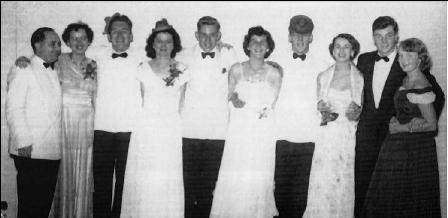 The annual presentation balls were now held at the Dungowan
near Martin Place in the city with up to three hundred attending. Tough liquor
laws then. Liquor if desired may only be pre-ordered at the Dungowan, no liquor
to be brought into the hall, then, in brackets (no bottles on the
table).
The annual presentation balls were now held at the Dungowan
near Martin Place in the city with up to three hundred attending. Tough liquor
laws then. Liquor if desired may only be pre-ordered at the Dungowan, no liquor
to be brought into the hall, then, in brackets (no bottles on the
table).
The local families continued to join the club. The Bate family (H.C., George, Ted and Norm), Gordon Ingate, later Australian 5.5 metre champion and to represent Australia in the Tempest class at the Olympic games, and David Forbes nominated June Jensen, later to become David’s wife. Mr. J.G. Vaughan was made the club’s first honorary life member in 1950 for services rendered and for having the foresight to start the club.
Club Dissension
The continuing battle with council and the Lands Department must have been creating stress on the committee members. At the 1954 A.G.M. Mr. R Davidson was elected President over Doug Gravenor and at the next general meeting Mr. Gravenor accused the President of ballot rigging, branch stacking and seeking the presidency by irregular means. The treasurer, Ken Hudson (later to become Commodore of Royal Prince Alfred Yacht Club) mediated an eventual compromise.
Doug Gravenor had been leading the battle for club land and had personal contact with Rob Askin, the member for Collaroy and later the Premier of N.S.W. It was through Rob Askin’s personal intervention that permissive occupancy of the present site was granted by the Lands Department in August 1955.
The problem with the council’s acceptance of club architect, John Brogan’s plans, now reached an impasse. Council insisted that the club house incorporate brick public toilets in the construction which would be built and maintained by the Club. Luckily, two local doctors were on committee and wrote a comprehensive report about the dangers, both hygienic and moral, that young children could be exposed to, by the Council’s policy. The public toilets requirement suddenly went away.
During this tense period in the Club’s history Phil Rudder and his family joined. Phil owned a trucking company and immediately volunteered to start moving the stockpile of materials that had been collected for the clubhouse to a more central location, one of which was the Rubensohn’s property at Clareville.
The Clareville Beach Protection League which had objected to the erection of a clubhouse anywhere south of the park had promised substantial donations to the club if the building was erected elsewhere. 100 pounds was donated to the building fund in 1956 after a fair amount of lobbying. John Brogan and Bill Toft drew up a roster to construct the club at least up to the first floor level and on the 26th December 1955 the first of many club barbecues was held on site attended by 200 members, soft drinks donated by “Ecks”, the Forbes family company. No gas B.B.Q’s in those days and the first floor survived.
Enthusiasm created great results and by March 1956 the roof trusses were in position, but owing to the late hour finishing they were only tied into position with rope. A westerly gale, blowing dogs off chains, roared through that night and unfortunately blew down the tethered trusses as well. A tough mob in those days, by the end of March the under roof wire mesh was in position and the fibro roof attached to the new trusses that replaced the old twisted ones.
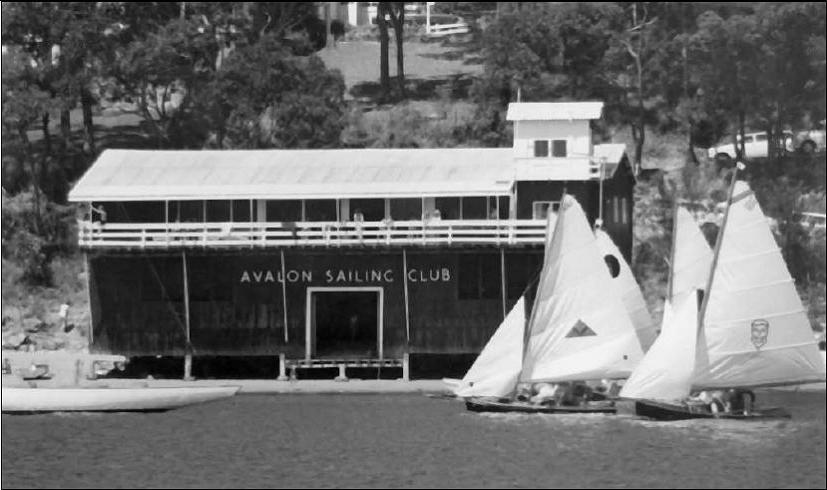
Avalon Sailing Club 1963
The appearance of the club construction created a big influx of new members including the Ryves family, who were later to play a major role in the Club and Bill Northam a future Australian and Olympic champion 5.5 metre sailor. Bill offered a sail on his yacht Saskia as a prize for the winners of some of the V.J. races. The boatshed floor, upper floor and exterior cladding were rapidly added by the members so that the first committee meeting was held in the club house, albeit without electricity, toilet facilities or even widows in place, on Sunday 13th January 1957.
 Right:
Club Captain John Ryves instructing in 1958
Right:
Club Captain John Ryves instructing in 1958
The provision of services down to the building were a problem at this stage, exacerbated by a Council ruling that no functions could be held at the clubhouse until the water and toilet facilities were in place. However the members were kept busy painting the inside frames and exterior cladding with sump oil. Well, why not, if the President owns a trucking company. In addition there were now lock up racks for 70 dinghies including the V.J., the V.S. and the new addition, the Moth.
The first A.G.M. was proudly held at the club house on the 15th September, 1957 with all facilities, including the kitchen, functional.
Tragedy at the Club
The opening of the club house for general use was marred by the death of one of the senior skippers, Warren Payne, on New Years Day 1958. He had been competing in a V.J. race for the Archina Cup when the fleet was hit by a southerly-buster at Long Nose Point. There were no local water police then and it was not a requirement to wear life jackets. Phil Rudder, the President owned a 48 foot sloop, the Janet M, and with club members on board they searched Pittwater until well into darkness to no avail. The V.J. council decided immediately that all competitors should wear some form of life jacket and Avalon decided that ‘one up’ sailing would no longer be permitted. In memory of Warren a perpetual championship trophy, the Warren Payne Trophy, was donated to the Club and it is still in the trophy cabinet and a valued prize today.
The Opening of the Clubhouse
Most of 1958 was spent organizing the final touches to the exterior and connecting the services. It was decided that there would be an official opening ceremony and that the Governor General would be asked to officiate. Might as well try for the top if you have been waiting twenty frustrating years. The G.G. must have been busy that particular day as the eminent person who opened the club house on October 5th 1958, was Admiral H.J. Buchanan, C.B.E./D.S.O., aide-de-camp to both King George VI and Queen Elizabeth II. Afternoon tea and sandwiches were served and Admiral and Mrs. Buchanan watched the races from the starting tower.
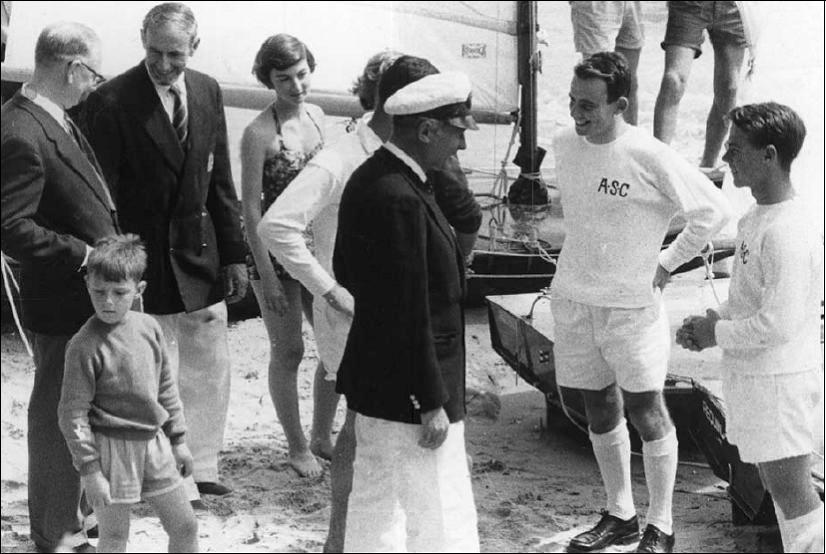
Opening day of the Avalon Sailing Club clubhouse; Phil Rudder, Annette Friend, Admiral H J Buchanan and boys in uniform; Bill Davidson and Hamilton Hunter
The trade off was easy. Both Phil and Admiral Buchanan were involved in the formation of the Outward Bound School which was located at Bar Island in the Hawkesbury and later owned by Knox Grammar School. A.S.C. donated 6 old V.J.s to the O.B. school. They were sailed there by Gawen, David and Philippa Rudder and three other skippers, monitored by John Brogan in a launch.
In 1959 Phil organized some of the older boys who were outgrowing V.J’s to keep them interested in sailing to crew on his 47 foot sloop Blue Water in the Montague Island race. On their way north they were hit by a 50 knot squall which tore out a headsail winch and in zero visibility they hit an island off Batemans Bay. The A.S.C crew of 18 year olds included Bill Davidson, Hamilton Hunter, John Brogan, David Rudder and Tony Catts. Phil was down below suffering from kidney stones and with great presence of mind the crew remembered him and they all spent the next 16 hours on an exposed rock until rescued by a trawler. Remember in those days no requirement for life rails, no G.P.S., primitive radio comm., and navigation by Astro, D/F. radio and dead reckoning. Phil died in 2004, aged 94, shortly after re-visiting the club and being made a life member.
Most of my information has come from the old minutes of the club meetings and talking to some of the “originals” and the club trophies that are still in the trophy cabinet. We have always had a good proportion of lady skippers and the trophy for the outstanding lady skipper was presented by Mary Ifould, who was an outstanding Flying 15 skipper. Mary was secretary of the club in 1961 and used to drive her children over to the club from the holiday home at Lovett’s Bay in a tinnie for the races. The children were safe with the club so she bought an F15 called Trio.
The story of Mary and her husband Lister is part of Australian history. Mary’s first husband John Frankcomb was a bomber pilot in WW2 flying Short Stirlings and was killed in a raid over Germany. Some time later she married Edward Lister Ifould who had been a navigator on the same squadron and he was chosen to join the elite Pathfinder squadron, flying Avro Lancasters to drop special flares from low altitude on designated targets. The attrition rate for the Lancasters was quite high and luckily along came a small very fast twin engined fighter-bomber, made of wood, the Dehavilland Mosquito, that the Air Ministry did not want. Lister’s boss A.V.M. Don Bennett, another Australian and founder of the Pathfinder force, grabbed them with glee. Bennett and Ifould (now a squadron leader) flew as a team for the rest of the war. Lister was awarded the D.S.O, the D.F.C. and Bar and there is an oil painting of him in the A.W.M. in Canberra.
The children were now older so they decided to sail together as a family, bought a Dragon and moved on to the R.P.A.Y.C. Lister was part of the crew that won the Hobart Race on Struan Marie. Mary’s legacy is the permanent trophy in the club.
The Introduction of the Manly Junior
In 1962 it was decided to introduce a training boat so that young sailors could create a nucleus to continue racing the V.J. Ten parents started the programme by building the first ten boats and a series of lectures was given in November to demonstrate the new boats. To the concern of the President, Paul Hennessy and committee, 65 boys and girls turned up. This explosion in membership forced the club to close its open list until the amenities and racking system could be upgraded. The club hosted the M.J. State championships in 1963 and forty-four boats crossed the line in a brisk nor-easter on a five mile course around the torpedo targets.
The Vaughan Family
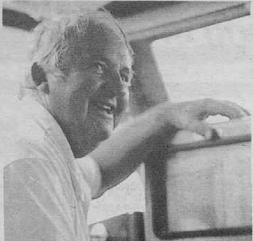 The
club started with the Vaughan family so it is probably opportune to finish the
story with the Vaughans. Les provided a lot of the early history and enthralled
our junior members with a talk he gave at an A.G.M. in 1999. His brother Harold
was one of the characters of Pittwater and is the first name on the V.J.
championship trophy sailing Defiant in 1939, the first V.J. on
Pittwater. Harold returned from war service in New Guinea and was still a
vice-president in 1951. He must have grown out of V.J.s as he was given the task
of finding a replacement. This turned out to be the V.S. which never succeeded.
The next was the Star which took off on Pittwater and the Olympics.
The
club started with the Vaughan family so it is probably opportune to finish the
story with the Vaughans. Les provided a lot of the early history and enthralled
our junior members with a talk he gave at an A.G.M. in 1999. His brother Harold
was one of the characters of Pittwater and is the first name on the V.J.
championship trophy sailing Defiant in 1939, the first V.J. on
Pittwater. Harold returned from war service in New Guinea and was still a
vice-president in 1951. He must have grown out of V.J.s as he was given the task
of finding a replacement. This turned out to be the V.S. which never succeeded.
The next was the Star which took off on Pittwater and the Olympics.
Harold had also joined R.P.A.Y.C. and started the Jubilee class there. He was world 5.5 metre champion in 1977 and won the Australian gold cup a number of times. He was involved in two of our America’s Cup campaigns and was a busy boat deliverer and as part of his crew had a few of our current A.S.C. members.
Left: Harold Vaughan
AVALON SAILING CLUB WEBSITE
Copyright Norm Field, 2012. All Rights Reserved.
|
|